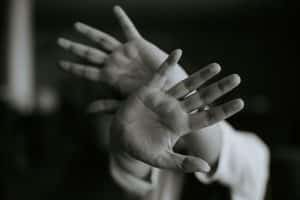The Scare Factor: How Your Attachment Style Influences Your Fears

Published on October 28, 2022 Updated on January 15, 2024
Are you the type of person that likes to watch a horror movie on your own, enjoying the feeling of fear that tugs at your gut? Did you spend your childhood telling ghost stories or daring your friends to knock at the door of the local “haunted” house? If you did, you’re most certainly not alone.
Fear is an emotion as old as humankind itself. Hence, the reason why scary stories are so embedded in our history. They were, in many ways, used to ward us away from the threats we may have encountered if left to our own devices. Werewolves, vampires, creatures from the deep – all great examples of how we were taught to rely on our instincts in the face of potential danger. But the horror genre has taken a turn in recent years and instead reflects the more internal fears that many of us encounter on a day-to-day basis.
The fears of being rejected and abandoned are ones that seem to tap into the universal zeitgeist. More so than any creature or monster that can plague our dreams, these fears often feel too uncomfortably close to home. They tap into our deepest, darkest nightmares and shake us to our cores. Some of us may be more prone to these fears than others – especially those of us with insecure attachment styles.
To help you understand how your attachment style may influence your fears, as well as how you respond to them, this article covers:
- How we respond to fear in general
- Attachment theory’s association with fear
- The attachment anxiety and avoidance fear responses
- What you can do to manage your attachment-related fear responses
How Do We Respond to Fear?
Some of us enjoy being scared – because, in the aftermath of a non-life-threatening situation, we’re often flooded with feelings of pleasure. Fear gives us a rush of hormones, priming us for danger. So, in a way, we experience kind of a high.

This response was passed down in our genes from our ancestors – because, ultimately, fear is vital for our survival. This automatic response allows us to respond appropriately to situations that may be dangerous for us. Essentially, it’s an adverse urge to get out of a threatening circumstance.
When we encounter such a threat, two pathways in our brains are activated. The first response is incredibly fast, as it calls for immediate action in response to the threat. This initial reaction is the transmission of information from the sensory thalamus to the amygdala – the small bunch of neurons in our brains that control our fear responses. This stage allows us to react immediately to an imminent risk to our safety.
The second stage of our fear response is more contingent on the situation that triggered it. In this stage, information is passed from the thalamus to the cortex – the area of the brain concerned with reasoning, consciousness, and memory. During this phase, we experience enhanced attentiveness to our environment and make a reasoned decision regarding whether or not we are in immediate danger. Ultimately, this stage drives our behavioral response and allows us to determine whether we fight, flee, or freeze in the face of a threat.
Attachment and Fear
As we discussed – it’s not just masked killers, rollercoasters, and haunted houses that trigger our fear responses. According to attachment theory, the attachment style we develop as children also influences what we perceive to be fearful situations – and how we respond to them. The fight, flight and freeze responses may be biologically wired-in to help us navigate and survive difficult terrains and stimuli – but they also get in the way of how we lead our relationships at times.
Think of it this way; when your fear is triggered by a relational issue, such as a fight with your partner or someone wishing to get too emotionally attached to you – do you choose to push (fight) for closeness, or do you run from the situation (flee)?
The fight and flight responses can become hardwired reactions to our environment based on trauma that we experienced at an early age. Essentially, these responses may be influenced by our early beliefs about how relationships work, and we may use them as a form of “defense” against further trauma or fear.
Bear in mind – humans are, by nature, incredibly complex. How we react to potentially fearful situations will ultimately be impacted by a variety of motivational factors and life experiences. Furthermore, attachment is a spectrum, so our attachment styles may be transient across our lifespans and circumstances.
*note – disorganized attachers tend to vacillate between the anxious and avoidant dimensions of attachment depending on their circumstances. Use this knowledge to determine your fear responses in relationships from the following information.*
The Attachment Anxiety Fear Response
People high on attachment anxiety’s needs were likely treated inconsistently in their formative years. Therefore, as adults, they are likely to show increased behavioral, physiological, and emotional responses to even mildly stressful situations.
Anxious attachers also tend to lack a sense of permanence in their situation. They also feel a sense of helplessness when faced with stress. Due to these feelings of powerlessness, anxious attachers engage their “fight” response when their attachment traits are triggered by stress. In that case, they vigilantly search for reassurance and support – especially in their relationships. So, how does this pattern of behavior play out during a pandemic?

When we encounter a threat – either real or perceived – our bodies often spring into action by either screaming or fighting against the fear. For someone with an anxious attachment style, their “worst nightmare” is often the fear of abandonment. As a child, their caregivers were selectively attentive, so the child started to understand that they could only derive the response they wanted from their caregivers by fighting to get their attention through tantrums or people-pleasing.
So, as an adult, an anxious attacher projects their understanding of how relationships work onto their adult dynamics. Therefore, if they fight with their partner, detect threats to their relationship, such as a new friend, or if their partner seems distracted, they find themselves faced with a fearful situation.
So what would their fear response be? Anxious attachers are hardwired to “fight” against threats to their relationships. To flee would mean that they may lose their partner, so they engage in reactive strategies such as pushing for closeness and intimacy or even denying their own needs and wants to keep the other person happy and engaged in the relationship. They may even create arguments to test out their partner’s level of commitment to them, which ultimately may even drive them away.
But actions such as these may mean that an anxious attacher could lose a sense of who they are in a relationship – and they may even stay in a toxic one to avoid being alone.
The Attachment Avoidance Fear Response
In contrast to how someone high on attachment anxiety may “fight” against their fear of abandonment, someone high on attachment avoidance learned at a young age that such reactions would likely be either punished or ignored. Therefore, there was no point in pushing for the response that they wanted from their caregiver – fighting their fear simply wasn’t a viable option.

Instead, avoidant attachers often dissociate and “flee” from their fear of rejection and closeness. They typically develop a fierce sense of independence as they expect that others will let them down. So to avoid becoming a target, they learn to rely only on themselves.
Someone high on attachment avoidance may even develop alexithymia – a fear of intimacy. Alexithymia is characterized by the reduced capacity to share thoughts, feelings, and emotions with others, as well as constructing impossibly high personal boundaries.
So, before an avoidant attacher can even be faced with the possibility of rejection and abandonment in a relationship, they tend to look for escape routes. If someone close to them pushes for increased intimacy and emotional closeness, their fear response is triggered – which, as we now know – is flight.
Fleeing from commitment may come in the form of withdrawal from the relationship. However, it can also look like hyper-discernment, as the avoidant attacher may focus on tiny flaws as reasons to end a relationship and make finding the “perfect” partner their ultimate goal – which, of course, is an impossibility.
Ultimately, an avoidant attacher typically erects active and impenetrable boundaries to preserve their sense of self and avoid rejection. They may not even realize that they have a deep-rooted fear of being alone, as they likely dissociated from it at a young age.
How to Manage Your Attachment Fear Response
Clearly, fears of abandonment, rejection, and intimacy can have detrimental effects on relationships. But, seeing as our fear responses are so hard-wired, is there anything we can do about them? Thankfully, the answer is yes. However, changing automatic fear responses may take understanding, hard work, and practice.
The first thing you can do if you think that your attachment style is triggering a fear response in your relationships is to try to remember that you have a very quick emotional response to triggering situations.
Keeping this in mind, as soon as you sense that your fear response is being triggered – PAUSE. Take a deep breath and allow your more logical, cortical response to catch up with your emotional one. Doing so allows you to think about more balanced and healthy ways to respond to a situation – ones that will more likely you the outcome you want.
Alternatively, if you’re struggling to get past your fears, it may be important to speak to a mental health professional. Trained therapists are skilled at getting to the root of a problem or fear and helping you understand what drives your emotions and behaviors.
After all, as the master of fear, Stephen King, put it, “Monsters are real, and ghosts are real too. They live inside us, and sometimes, they win.” Don’t let your internal monsters win. Even the most balanced, successful people experience fears – but they choose to conquer them.
References
Besharat, M. A., Naghshineh, N., Ganji, P., Tavalaeyan, F. (2014). The Moderating Role of Attachment Styles on the Relationship of Alexithymia and Fear of Intimacy with Marital Satisfaction. International Journal of Psychological Studies, 6(3).
Öhman, A. (2007). Fear. Encyclopedia of Stress (Second Edition). Elsevier. Porges, S. W. (2011). The Polyvagal Theory: Neurophysiological Foundations of Emotions, Attachment, Communication, and Self-Regulation. New York, NY: W. W. Norton.
Porges, S. W. (2011). The Polyvagal Theory: Neurophysiological Foundations of Emotions, Attachment, Communication, and Self-Regulation. New York, NY: W. W. Norton.











 Get mental health tips straight to your inbox
Get mental health tips straight to your inbox








